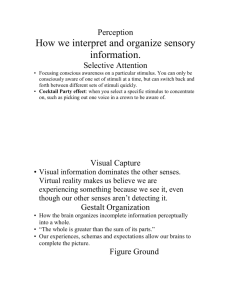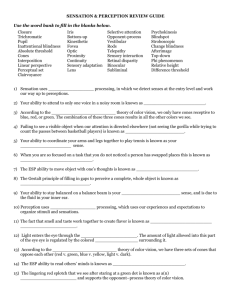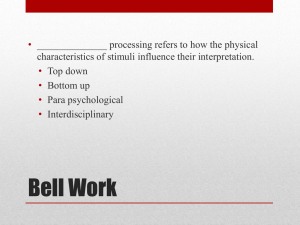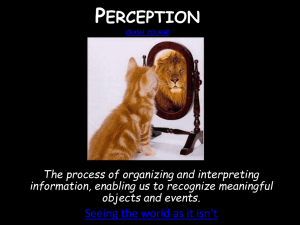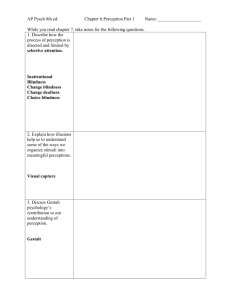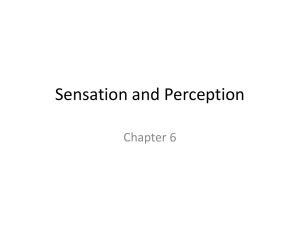Unit 4
advertisement
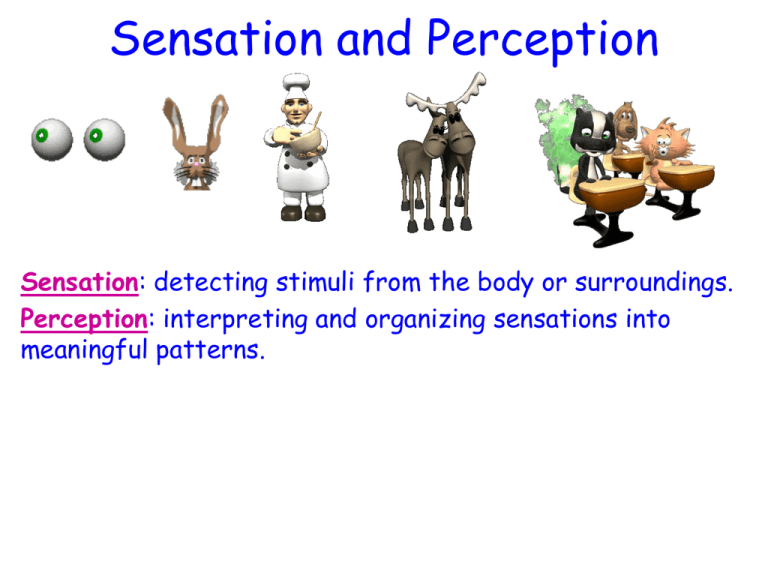
Sensation and Perception Sensation: detecting stimuli from the body or surroundings. Perception: interpreting and organizing sensations into meaningful patterns. Bottom-Up Processing • Info processing that analyzes raw stimuli entering through our sensory systems. • We use the features on the object itself to build a perception. • Takes longer than top-down but is more accurate. Top-Down Processing • Info processing that draws from expectations and experiences. • I _ant ch_co_ate ic_ cr_am. • If you see many old men in glasses, you are more apt to process a picture of an old man (even when you may be in error). What if we could sense everything? Life would hurt. So we can only take in a window of what is out there. Psychophysics: studies the relationship between physical stimuli and our psychological experiences to them. Absolute Threshold • The minimum amount of stimulation one can detect through a given sense 50% of the time. Absolute Thresholds • Taste: 1 teaspoon of sugar dissolved in two gallons of water. • Smell: 1 drop of perfume diffused throughout a three-room apartment. • Touch: the wing of a bee falling on your cheek from a height of 1 centimeter (.39 inch). • Vision: a candle flame seen from 30 miles on a clear, dark night. • Hearing: the tick of a watch from 20 feet in very quiet conditions. • http://www.phys.unsw.edu.au/jw/hearing.html Difference Threshold (Just Noticeable Difference) The minimum amount of change in stimulation that can be detected. Signal Detection Theory • States that absolute thresholds are not really absolute. • Things like motivation or our physical state can effect what we sense. A mom could sleep through a war, but if one of her kids even whimpers, she is up!!! Subliminal Stimulation • Below one’s absolute threshold for conscious awareness. Do subliminal messages work? Most evidence suggests it’s not effective. Subliminal Messages: The Early Years • James Vicary claimed to have flashed the words “eat popcorn” and “Drink Coca-Cola” on a movie screen for 1/200th of a second, every 5 seconds during the movie Picnic. • He claimed popcorn sales increased 58% and Coke sales increased 18%. • Vicary’s experiment was never successfully replicated • He later acknowledged the study was a fraud. The Middle Years: Embedded images and text • Embedded images and text are subliminal messages. • This ad for Tanqueray allegedly contains a phallic symbol. Recent Years: Product placement • Product placement is a form of supraliminal persuasion. • Subtle, perhaps, but not subliminal. Embedded images in Disney movies • The Little Mermaid – The artist who painted this scene claimed the resemblance to a phallic symbol was unintentional. More Disney embedding • The Rescuers Down Under (who’s in the window?). • The Lion King. More embedding… • Pall Mall cigarettes and embedding? – Some claim that the banner on the bottom of the Kent cigarette package shows two KKK Klansmen. • Pepsi and embedding – The graphics on the cans line up to form the word “SEX.” Embedding as a conspiracy theory • Examples of embedded images appear to be isolated cases. – The incidents appear to be pranks rather than organized marketing strategies. – The mere existence of subliminals does not prove their effectiveness. Are there hidden messages in song lyrics? • Can the mind detect lyrics that might be played in reverse? • http://jeffmilner.com/b ackmasking/index.html Sensory Adaptation • Tendency of sensory receptors to respond less and less to constant stimulation (Diminished sensitivity). Do you feel your underwear all day? Selective Attention • An example of selective attention is the cocktail party effect which is the ability to focus one's attention on a single talker among a mixture of conversations. • Cocktail-party activities. Selective Attention & the Stroop Effect Your right brain tries to say the color, your left reads the word. Energy vs. Chemical Senses Energy Senses Chemical Senses Vision • Our most dominating sense. • The eye is like a camera (it needs light). Phase One: Gathering Light • • • • • The height of a wave gives us it’s intensity (brightness). The length of the wave gives us it’s hue (color). ROY G BIV The longer the wave the more red. The shorter the wavelength the more violet. Phase One: In the Eye The Blind Spot is where there are no Rods or Cones.(Blind Spot Activity) Structures of the Eye • Iris – regulates the amount of light going into the eye (colored part). • Pupil – black opening where light enters. • Lens – focuses light on the retina. • Retina – has layers of sensory cells: Cones – (6 million) for color and daylight vision. Most highly concentrated near the fovea (back center of the eye). Rods – (120 million) for peripheral and night vision. Located along the sides of the retina. (do the peripheral vision activity) *** And note the rods and cones numbers in your text are backwards!!! The Retina Phase Two: Vision In the Brain We have specific cells that see the lines, motion, curves and other features of this turkey. These cells are called feature detectors. Show The Brain (Module 8) “Elementary Visual Concepts” (3-6 min.) • Goes to the Visual Cortex located in the Occipital Lobe of the Cerebral Cortex. • It’s here that we interpret what we are looking at. Visual Pathway Show Secrets of The Mind - “Blindsight” (15-23 min.) Facts on Color Vision Colors we experience depend on the relative degree of stimulation to the cones. Pigments mixed together absorb more wavelengths than a single pigment (subtractive color mixing) Wavelengths added together stimulate more cones (additive color mixing) Color Vision Two Major Theories Trichromatic Theory Three types of cones: • Red • Blue • Green • These three types of cones can make millions of combinations of colors. • Does not explain afterimages or color blindness well. Opponent-Process theory The sensory receptors come in pairs. • Red/Green • Yellow/Blue • Black/White • If one color is stimulated, the other is inhibited. Afterimages Afterimages • When the eyes are then diverted to a blank space, the adapted photoreceptors send out a weak signal and those colors remain muted. However, the surrounding cones that were not being excited by that color are still "fresh", and send out a strong signal. The signal is exactly the same as if looking at the opposite color, which is how the brain interprets it. Color Blindness Missing Red Missing Green Missing Blue Types of color blindness: • Red / Green (most common) • Blue / Yellow • Total colorblindness • Most colorblind people are dichromats – they lack one kind of photopigment. • Males more likely to be colorblind. Hearing (Audition) Our auditory sense Hearing is produced by sound waves. Frequency: the number of complete wavelengths that pass through point at a given time. This determines the pitch of a sound or how high or low a sound is. Amplitude or Intensity: is how loud the sound is. The higher the crest of the wave is the louder the sound is. It is measured in decibels. Write this Structures In the Ear • Sound waves hit the eardrum; then the middle ear bones. • Everything is just vibrating. • Then the cochlea vibrates. • The hair cells (cilia) in the fluid filled cochlea vibrate. • Then signals are sent to auditory nerve, up to the thalamus and on to the auditory cortex. It is all about the vibrations!!! The Ear Sound Localization Demonstration Hearing Deficits Older people tend to hear low frequencies well but suffer hearing loss when listening for high frequencies. Deafness Conduction Deafness • Something goes wrong with the sound and the vibration on the way to the cochlea. • You can replace the bones or get a hearing aid to help. Nerve (sensorineural) Deafness • The hair cells in the cochlea get damaged. • Loud noises (concerts) can cause this type of deafness. • NO WAY to replace the hairs. • Cochlea implant is possible. Localization of Sounds Because we have two ears, sounds that reach one ear sooner than the other ear cause us to localize the sound. It’s also louder for one ear. Taste and Smell Why do we study smell and taste together? • SENSORY INTERACTION: the principle that one sense may influence another. Taste • We have bumps on our tongue called papillae. • Taste buds are located on the papillae. • Sweet, salty, sour, bitter and umami (savory). • Bitterness detectors – critical because most poisons are bitter. • Sour detectors – detect bad foods. • Built-in salt and sugar needs for survival. Back of the tongue Tip of the tongue Sci. American: Tasters and Supertasters; PTC Strips Activity and Food Coloring. Smell (Olfaction) • Olfactory Cells – receptor cells that collect molecules of odor. • Olfactory bulbs – receives an electrical signal and generates a “code” that is sent to the brain for interpretation. Touch (Cutaneous Senses) • Cutaneous receptors are located in our skin. • Three types: pressure, cold, heat, & pain. • Gate Control Theory Gate Control Theory • Contends that there is an area in the spinal cord that can act like a “gate” and either inhibit pain messages or transmit them to the brain. • When tissue is injured, the small nerve fibers activate and open the neural gate, and you feel pain. • Large-fiber activity closes the pain gate, turning pain off. Phantom Limb Pain • Phantom limb pain is a frequent complication of amputation. • Client complains of pain at the site of the removed body part, most often shortly after surgery. • Show Phantom Limb Video (Secrets of the Mind) Vestibular Sense • Tells us where our body is oriented in space. • Our sense of balance. • Located in our Semicircular Canals in our ears. Kinesthetic Sense • Tells us where our body parts are. • Receptors located in our muscles, joints and tendons. Without the kinesthetic sense you could not touch the button to make copies of your buttocks. Perception Gestalt Psychology • Gestalt means “an organized whole.” • These psychologists emphasize our tendency to integrate pieces of information into meaningful wholes. Gestalt Psychology • To perceive forms, we must organize the visual field into objects (figures) that stand out from their surroundings (ground). • This is figure-ground perception. Gestalt Grouping Principles • Gestalt psychologists focused on how we GROUP objects together. • We innately look at things in groups and not as isolated elements. • Proximity (objects that are close together are seen as being part of same group). • Similarity (objects similar in appearance are perceived as being part of same group). • Continuity (objects that form a continuous form are perceived as part of the same group). • Closure (we fill gaps in if we can recognize it). Gestalt Grouping Principles Depth Perception • The ability to see objects in three dimensions although the images that strike the retina are two dimensional. • Allows us to judge distance. Depth Cues • Eleanor Gibson and her Visual Cliff Experiment. • If you are old enough to crawl, you are old enough to see depth perception. • We see depth by using two types of cues: • Monocular Cues (w/ 1 eye) • Binocular Cues (w/ 2 eyes) Monocular Cues • Interposition: if something is blocking our view, we perceive it as closer. •Relative Size: if we know that two objects are similar in size, the one that looks smaller is farther away. •Relative Clarity: we assume hazy objects are farther away. More Monocular Cues • Texture Gradient: distant objects look smoother than closer objects. •Relative Height: things higher in our field of vision, they look farther away. •Relative Motion: things that are closer appear to move more quickly. •Linear Perspective: parallel lines seem to converge with distance. Monocular Cues • • • • • • Examples of… Linear Perspective Interposition Relative size Texture gradient Relative Motion Motion Perception • Stroboscopic effect (flip book effect). • Phi phenomenon (blinking neon lights; like the marquee in front of the school). Binocular Cues • We need both of our eyes to use these cues. • Retinal Disparity – slightly different images produces by the retina of each eye. • Convergence - degree to which our eyes turn inward to focus on an object. Perceptual Constancy • Perceiving objects as unchanging even as illumination and retinal images changes. Perceptual Constancy • • • • Types of Constancy Shape Constancy Size Constancy Lightness Constancy Perceptual Set • Mental predisposition to perceive one thing and not another. • http://www.ted.com/talks/michael_shermer_on_believing_strange_things.html • What you see in the center picture is influenced by a perceptual set. (A good example of top-down processing). • Based on schemas (mental frameworks). Illusions = inaccurate perceptions • Not always a “mistake” by us; sometimes we change what we perceive so that the world makes more sense. • Sometimes we make guesses in the context of what we think should be the case. Famous Illusions Muller-Lyer Illusion Ames Room Extrasensory Perception • Extrasensory perception (ESP): the ability to perceive events without using normal sensory receptors. • Parapsychology: the field that studies ESP and other paranormal phenomena. Types of ESP – Telepathy: the ability to read minds. – Clairvoyance: the ability to perceive objects or events. – Precognition: the ability to predict the future. – Psychokinesis: the ability to move objects. There Is Little Scientific Evidence for Extrasensory Perception!!! • Reasons for skepticism: – Many published ESP studies have used flawed research methodologies or failed to detect outright fraud by those they were testing.

